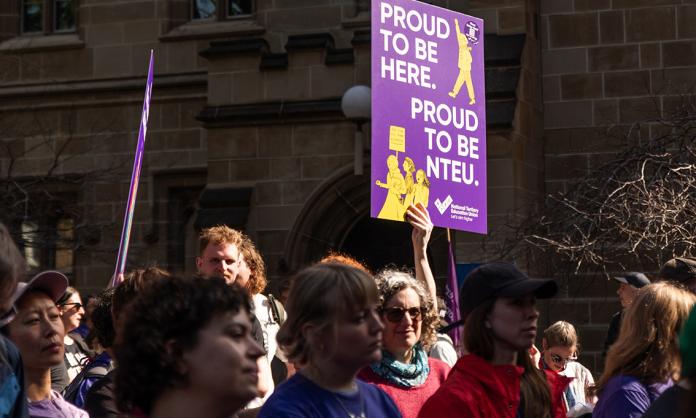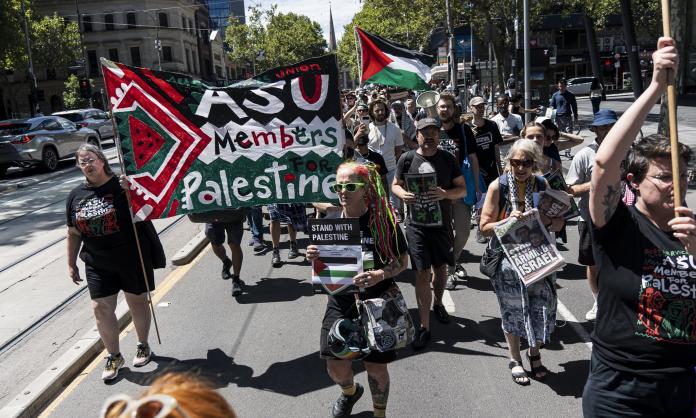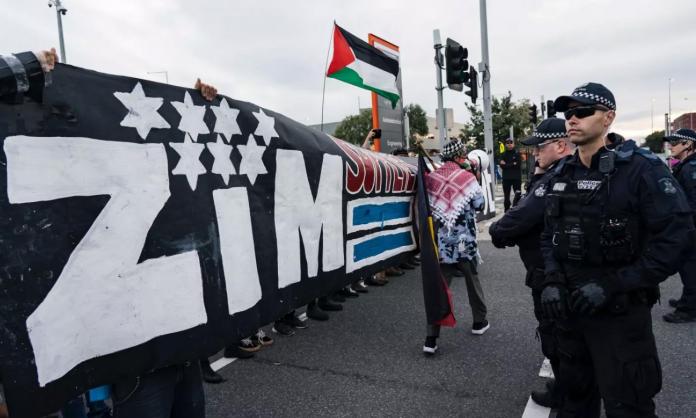Two record-breaking union meetings at Melbourne University have voted overwhelmingly for another week-long strike, starting on 2 October.
Members of the National Tertiary Education Union struck for a week from 28 August in support of an ambitious set of demands including filling all vacant positions, a default 40 percent research fraction for academics, a strict limit on restructures, enforceable rights to work from home and a pay rise that catches up to inflation by 2025. Though that strike was limited to five specific areas (Arts, Law, libraries, the Victorian College of the Arts and the main student services hub at 757 Swanston Street), it was the first major week-long university strike in the 30-year history of the NTEU.
Before the strike, management had spent a year deriding one of the union’s key demands—that 80 percent of staff have ongoing jobs (compared with fewer than half of staff currently in ongoing roles). While job security ratios have been won in many workplaces, they are rare in higher education. Management at Melbourne Uni said that they would never agree to any such restriction on their ability to determine the mix of the workforce.
But on 8 September, a week after the strike and less than an hour before a union meeting was due to consider next steps, management dropped a new offer on “workforce planning”. A “flexible” workforce of casuals and fixed-term staff with a contract of less than a year would be limited to 25 percent of the total, with the remaining 75 percent of workers to be classified as “core” workforce.
Management’s inclusion of fixed-term staff with contracts as short as a year in the “core” workforce meant this offer was far short of the union’s “80 percent ongoing” claim. But suddenly, management were moved to start talking on the union’s terms.
Clearly, their 8 September offer was designed to undermine any push to continue the industrial campaign. It failed. Instead, a record 400-strong union meeting voted to ignore a recommendation from the bargaining team to pause industrial action, and voted two-to-one to endorse another week-long strike.
Union members met again on 28 September to consider whether sufficient progress had been made to call off the strike. The meeting was another record, peaking at over 450 members. A whopping 82 percent voted to strike from 2 October. Not a single member spoke against the strike motion.
A large-scale, week-long university strike was unheard of in the NTEU until this dispute. It’s an enormous credit to the dedicated activists in Arts, with a track record of solid organising to recover stolen wages in recent years, that such a feat is now not just thinkable but doable.
It’s also a significant achievement by union members in 757 Swanston, libraries, Law and the VCA to demonstrate in practice during the last strike that serious organising can lead to a serious strike in areas without the recent history of intensive organising that Arts has had.
This opened the way for the strike to be extended to all union members—a step up on the “area by area” approach of the previous strike. This will allow strikers to spend the coming week inviting fellow workers to join the union, and join the strike, right across the university.
There are serious challenges ahead, of course—and not just the wet weather forecast for Melbourne this week. Week-long strikes have more impact than the half-day or one-day strikes, which have been the stock in trade of the NTEU for many years. But it’s still possible for management to plan around them. And although the Melbourne Uni NTEU branch is now the largest in the country, we’re still a minority of the workforce.
So we’re still yet to achieve the sort of mass, indefinite strike action that university workers have pulled off in the US recently, which sent management into serious crisis and won major improvements in wages, conditions and job security.
The other significant challenge is the NTEU’s national leadership, which has wound up industrial campaigns and declared a “union win” at many campuses despite achieving only a small number of ongoing positions (most or even all of them teaching-only), pay rises well behind inflation and in some cases (most notably Sydney Uni, the long-established NTEU pacesetter) significant cuts to long-established conditions.
The industrial campaign at Melbourne Uni has demonstrated in practice many of the elements of successful union breakthroughs: the power of serious, consistent organising; the ability of ambitious claims to inspire; how serious industrial action and an active strike (where members are engaged in daily activity, not just sitting at home passively) can generate a whole new layer of activists.
Being able to push past the limits set by a concessionary national leadership is another ingredient necessary if union members at Melbourne are to win significant gains.










